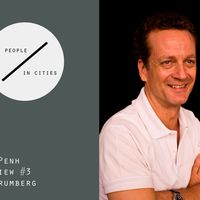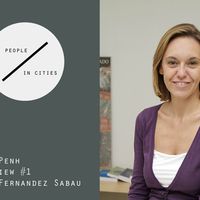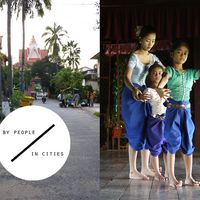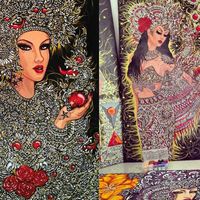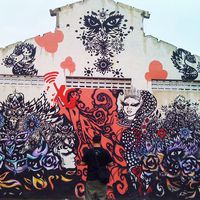By People / In Cities : Phnom Penh | interview with Mirana Randriananja

The second interview for By People / In Cities: Phnom Penh invites Mirana Randriananja to share her views on Cambodian art and culture. and reflect on the current transformations taking place in Phnom Penh. She works as the Communications Manager for Artisans Angkor, a social company specialised in Khmer Arts and Crafts.
Q: If you had to pick one word to describe Phnom Penh, what would it be?
Evolution! During the two years I lived in Phnom Penh, I saw the city change at such a fast pace that when I left, it was hard to recognize that it was the same place I got to know at my arrival. New skyscrapers, restaurants, hotels, cultural venues open all the time and get higher standards. I now live in Siem Reap but every time I go to Phnom Penh, I am amazed by my memories of this little village-town which is now on its path to become a vibrant must-see city.
Q: How would you articulate the relationship between cultural heritage and new creative practices in Cambodia?
Ancient architecture style of the omnipresent pagodas, traditional patterns of the fabrics worn for official ceremonies, Buddhist and Hindu sculptures used as home decoration, hand gestures of the dances in the nightclubs… The elements from the Angkor civilization still have a strong presence in Cambodian people's everyday life. Even popular rock bands use traditional Khmer music! As a part of the daily environment of the people, the cultural heritage remains a constant source of inspiration for Cambodian artists nowadays. This extraordinary artistic base enables countless possibilities of creative development. Artisans Angkor, which is a Cambodian company aiming at passing on the ancient traditional skills in craftsmanship while reviving the Khmer Arts and Crafts, currently strives to make of its new collection a mix between cultural heritage and contemporary style. The artistic department took inspiration from the Angkorian heritage and redefined some of its features with astounding modern colors and shapes. Most of the Cambodian young artists use their cultural heritage as a support to give a strong Cambodian identity to their works of art.
Q: What would help improve the situation for artists and arts organizations in Phnom Penh?
Being an artist, whether it is in New York, in Paris or in Phnom Penh, is a difficult choice to make since it is generally not known as a really lucrative activity – with a few exceptions of course. Given the economic situation of Cambodia, aid for the art sector is not abounding since other domains such as education and health were set as priorities for the country's development. This financial issue may lead to renunciation from talented artists with limited means, which represents a threat for the sustainability of the Cambodian artistic scene. Several associations and international institutions do promote certain artists or artistic activities, but in essence this is partial action. Global coordination and management of the sector could improve the overall situation of the artists but this may be quite difficult to set up in the context of a developing country.
Q: Do the arts and culture have the capacity to bring social change in Phnom Penh? And are they accessible enough for local people?
There is an increasing number of art spaces and arts associations that are opening in the capital; and well-established cultural centre like the German Meta House, the French Institute or even the Java Arts Gallery, organize on regular basis exhibitions that are a success with both local and expatriate public. The profile of the local public is most of the time young artists or students from the middle-class. As is often the case, an education background leads more easily to an interest for the arts. It would be a bit ambitious to say that arts and culture alone would be able to bring social change, but without doubt, they contribute to the evolution of mindsets. Late painter Vann Nath who depicted the haunting images of life under the Khmer Rouge regime, or filmmaker Rithy Panh, have undeniably left an indelible mark in the Cambodian cultural landscape. Their work and the work of the numerous other Cambodian artists who explore burning social themes act as a support for social change but absolutely have to be accompanied by educational explanations to be accessible to most of the local population. To me, education, including education to the arts and culture, is the most important vector of social evolution.
Q: How do you envision the future for young artists in Phnom Penh?
Phnom Penh is a capital city which now matters more and more on the international artistic scene: Christie’s, one of the worlds’ largest fine arts auction house held its first charity sale in Phnom Penh a few months ago, and a special event on Cambodian art named ‘Season of Cambodia’ is planned for next year in New York City. This increasing openness to the world will surely have positive effects on the aesthetics and creative potential of the emerging generation of artists. Besides, the country’s fast economic growth is already changing consumption patterns of the local residents of Phnom Penh. Even though the Cambodian art market currently mostly targets foreigners, those new consuming behaviors may lead the locals to have a different look on the arts, whether it is for investing or satisfying personal aspiration to a new lifestyle. This optimistic – but quite realistic – scenario implies that our young artists will get more requests for diversity in their art, but also more opportunities to give a new direction to Cambodian art.
Mirana Randriananja is French and has lived in Southeast Asia since 2008. She works as the Communications Manager for Artisans Angkor, a social company specialised in Khmer Arts and Crafts based in Siem Reap. Prior to her current role, she was in charge of Higher Education and NGOs at the Cooperation and Cultural department of the French Embassy in Phnom Penh. She also lived and worked in Singapore and Thailand. She holds a Master’s degree in International Relations, with a major in European and Asian studies.
www.artisansdangkor.com
By people / In cities is a series of articles and interviews that aims to enhance the understanding of art and culture in Southeast and East Asia through individual stories and perspectives including artists, cultural practitioners, and policy makers from the following 6 cities: Bangkok, Jogjakarta, Kuala Lumpur, Phnom Penh, Hong Kong and Singapore.
The second series introduces Phnom Penh, Cambodia, through its cultural heritage and the recent transformations that have been taking place at the intersection of traditional and contemporary practices.
Photo credit: Artisans d'Angkor

